By Byron Mutingwende
The situation seems normal to Joseph Mazango (not real name) who is a teacher at a makeshift school made from horse stables abandoned by the police in Snake Park. He has a class of over 100 pupils, some of whom are sitting on tree logs converted into benches while others are squatting on the floor.
“I am not even worried about such a condition because I was lucky to get a job just three months after getting my Diploma in Education. More than a half of my college mates are yet to be deployed to schools because the government has frozen new posts due to fiscal constraints. I am not worried about the squalid conditions here because the good thing is that I am teaching in an urban area near my family members,” Mazango says, taking a deep gulp of the local Maheu beverage.
Zimbabwe’s education sector had taken a nosedive during the hyperinflation era that saw most qualified teaching professionals seeking greener pastures in foreign countries. The land reform programme also led to the establishment of new settlements that saw the construction of satellite schools on farms and in the resettlement areas. Most of the new schools had dilapidated infrastructure and low staff resulting in high teacher-pupil ratios. The quality of education plummeted. During the unity government, donors came up with the Education Transition Fund that is now known as the Education Development Fund.
In an analysis report on Zimbabwe’s education sector referred to as the Education Medium Term Plan (2011-2015) for the Ministry of Primary and Secondary Education, which led to the development of the Education Sector Strategic Plan (2016-2020), Dr. Sue Kageler cited lack of funding of the education sector as a major challenge.
“The funding of the education sector continues to be a challenge. 99% of the funding from Government in 2014 was spent on salaries. The Basic Education Assistance Module (BEAM) funding is now negligible which will impact seriously on the vulnerable learners. The schools remit funds to the Better Schools Support Programme of Zimbabwe (BSPZ), which are used by district, provincial, the National Association of Primary Heads (NAPH) and National Association of Secondary Heads (NASH), and the parents/guardians are providing 96% of the schools income.
“Equity issues at the level of the district and school type (urban/rural, grant class, satellite/registered) have been highlighted which include issues of finance, outcomes, enrolment, gender, OVC status and disabilities. The MICS (2014) linked school attendance, the age of enrolment, primary completion rates and transition rates to secondary school to wealth quintiles and the level of the mother’s education,” Kageler said.
The reduction in the enrolment in primary schools was linked to poverty. In addition, the staffing levels at Head Office, Provincial and District levels were impacting on the implementation of the ministry’s programmes.
“Two areas of immediate concern are that the Poverty is a major factor in learners remaining in school, with lack of school fees being the main cause for dropouts or children being out of school as well as issues of corporal punishment and early marriages,” noted a part of the report.
It further noted that although funding to the Education Sector continued to increase from 2010 to 2014, and the Education Sector’s share of the budget allocation almost reached 30%, the amount of funding available to programmes decreased as the salary share of the funding went from 79% in 2010 to 99% in 2014.
Speaking at a media engagement meeting organised by the Zimbabwe Union of Journalists (ZUJ) to advocate for the right to quality, inclusive and equitable education at the Cresta Lodge Hotel in Msasa on Tuesday the 27th of June 2017, Maxwell Rafomoyo, the National Coordinator of the Education Coalition of Zimbabwe (ECOZI) said the funding of $29, 6m from Global Partnership for Education would go a long way in improving the sector.
Rafomoyo said in 2017 the Ministry of Primary and Secondary Education aimed to capacitate 2500 teachers in relation to the nuances of the curriculum but analysts felt that the plan was over-ambitious since the sector was grappling with fiscal constraints.
“There are also plans to focus on infrastructure development in 2017 by constructing new schools, classrooms and specialist rooms at 2053 schools but it seems to be a tall order due to the lack of funding,” Rafomoyo said.
ECOZI has taken part during the consultations and development of the new curriculum and continues to be part of the advocacy in its implementation. It also coordinates civil society organisations and teacher unions to conduct advocacy through commemorating international days such as Global Action Week for Education and World Teachers Day, Day of the African Child to mention just a few.






